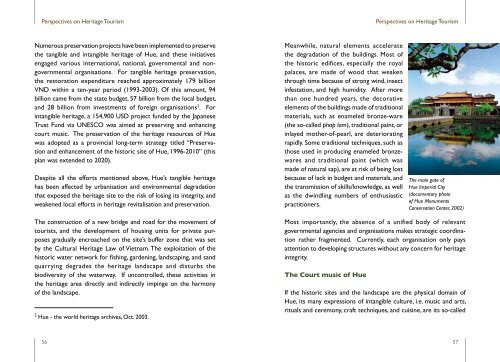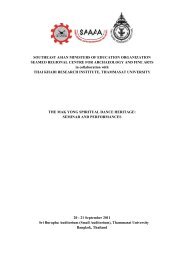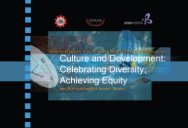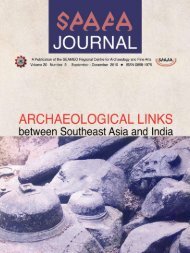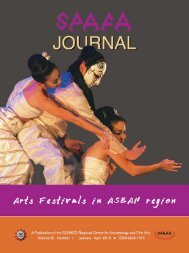Perspectives on Heritage Tourism - Seameo-SPAFA
Perspectives on Heritage Tourism - Seameo-SPAFA
Perspectives on Heritage Tourism - Seameo-SPAFA
You also want an ePaper? Increase the reach of your titles
YUMPU automatically turns print PDFs into web optimized ePapers that Google loves.
<str<strong>on</strong>g>Perspectives</str<strong>on</strong>g> <strong>on</strong> <strong>Heritage</strong> <strong>Tourism</strong><br />
<str<strong>on</strong>g>Perspectives</str<strong>on</strong>g> <strong>on</strong> <strong>Heritage</strong> <strong>Tourism</strong><br />
Numerous preservati<strong>on</strong> projects have been implemented to preserve<br />
the tangible and intangible heritage of Hue, and these initiatives<br />
engaged various internati<strong>on</strong>al, nati<strong>on</strong>al, governmental and n<strong>on</strong>governmental<br />
organisati<strong>on</strong>s. For tangible heritage preservati<strong>on</strong>,<br />
the restorati<strong>on</strong> expenditure reached approximately 179 billi<strong>on</strong><br />
VND within a ten-year period (1993-2003). Of this amount, 94<br />
billi<strong>on</strong> came from the state budget, 57 billi<strong>on</strong> from the local budget,<br />
and 28 billi<strong>on</strong> from investments of foreign organisati<strong>on</strong>s 2 . For<br />
intangible heritage, a 154,900 USD project funded by the Japanese<br />
Trust Fund via UNESCO was aimed at preserving and enhancing<br />
court music. The preservati<strong>on</strong> of the heritage resources of Hue<br />
was adopted as a provincial l<strong>on</strong>g-term strategy titled “Preservati<strong>on</strong><br />
and enhancement of the historic site of Hue, 1996-2010” (this<br />
plan was extended to 2020).<br />
Despite all the efforts menti<strong>on</strong>ed above, Hue’s tangible heritage<br />
has been affected by urbanisati<strong>on</strong> and envir<strong>on</strong>mental degradati<strong>on</strong><br />
that exposed the heritage site to the risk of losing its integrity, and<br />
weakened local efforts in heritage revitalisati<strong>on</strong> and preservati<strong>on</strong>.<br />
Meanwhile, natural elements accelerate<br />
the degradati<strong>on</strong> of the buildings. Most of<br />
the historic edifices, especially the royal<br />
palaces, are made of wood that weaken<br />
through time because of str<strong>on</strong>g wind, insect<br />
infestati<strong>on</strong>, and high humidity. After more<br />
than <strong>on</strong>e hundred years, the decorative<br />
elements of the buildings made of traditi<strong>on</strong>al<br />
materials, such as enameled br<strong>on</strong>ze-ware<br />
(the so-called phap lam), traditi<strong>on</strong>al paint, or<br />
inlayed mother-of-pearl, are deteriorating<br />
rapidly. Some traditi<strong>on</strong>al techniques, such as<br />
those used in producing enameled br<strong>on</strong>zewares<br />
and traditi<strong>on</strong>al paint (which was<br />
made of natural sap), are at risk of being lost<br />
because of lack in budget and materials, and<br />
the transmissi<strong>on</strong> of skills/knowledge, as well<br />
as the dwindling numbers of enthusiastic<br />
practiti<strong>on</strong>ers.<br />
The main gate of<br />
Hue Imperial City<br />
(documentary photo<br />
of Hue M<strong>on</strong>uments<br />
C<strong>on</strong>servati<strong>on</strong> Center, 2002)<br />
The c<strong>on</strong>structi<strong>on</strong> of a new bridge and road for the movement of<br />
tourists, and the development of housing units for private purposes<br />
gradually encroached <strong>on</strong> the site’s buffer z<strong>on</strong>e that was set<br />
by the Cultural <strong>Heritage</strong> Law of Vietnam. The exploitati<strong>on</strong> of the<br />
historic water network for fishing, gardening, landscaping, and sand<br />
quarrying degrades the heritage landscape and disturbs the<br />
biodiversity of the waterway. If unc<strong>on</strong>trolled, these activities in<br />
the heritage area directly and indirectly impinge <strong>on</strong> the harm<strong>on</strong>y<br />
of the landscape.<br />
2<br />
Hue - the world heritage archives, Oct. 2003.<br />
Most importantly, the absence of a unified body of relevant<br />
governmental agencies and organisati<strong>on</strong>s makes strategic coordinati<strong>on</strong><br />
rather fragmented. Currently, each organisati<strong>on</strong> <strong>on</strong>ly pays<br />
attenti<strong>on</strong> to developing structures without any c<strong>on</strong>cern for heritage<br />
integrity.<br />
The Court music of Hue<br />
If the historic sites and the landscape are the physical domain of<br />
Hue, its many expressi<strong>on</strong>s of intangible culture, i.e. music and arts,<br />
rituals and cerem<strong>on</strong>y, craft techniques, and cuisine, are its so-called<br />
56<br />
57


